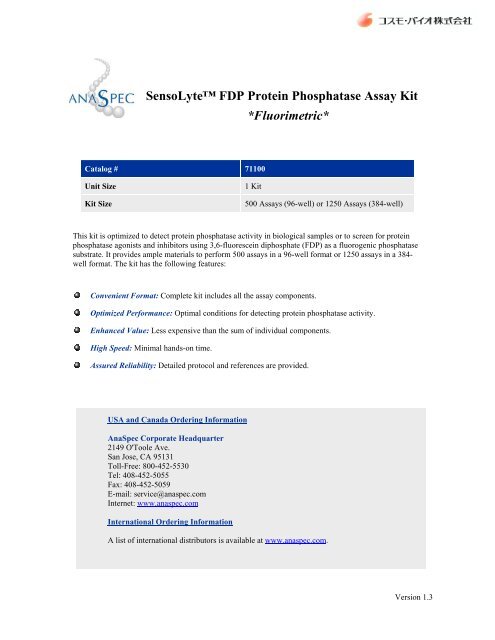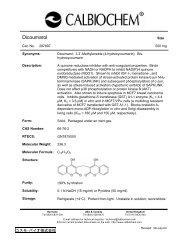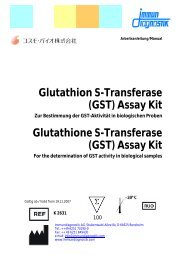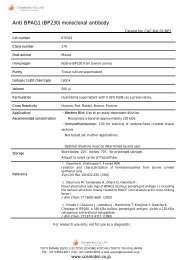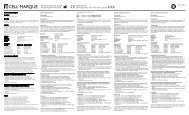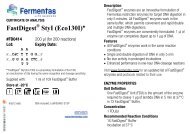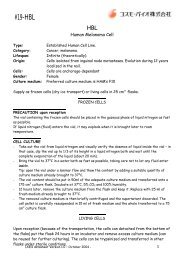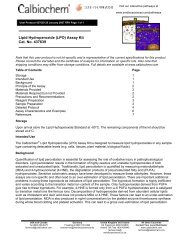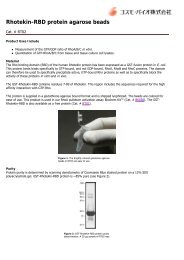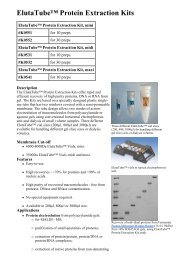SensoLyte™ FDP Protein Phosphatase Assay Kit *Fluorimetric*
SensoLyte™ FDP Protein Phosphatase Assay Kit *Fluorimetric*
SensoLyte™ FDP Protein Phosphatase Assay Kit *Fluorimetric*
You also want an ePaper? Increase the reach of your titles
YUMPU automatically turns print PDFs into web optimized ePapers that Google loves.
SensoLyte <strong>FDP</strong> <strong>Protein</strong> <strong>Phosphatase</strong> <strong>Assay</strong> <strong>Kit</strong><br />
<strong>*Fluorimetric*</strong><br />
Catalog # 71100<br />
Unit Size 1 <strong>Kit</strong><br />
<strong>Kit</strong> Size 500 <strong>Assay</strong>s (96-well) or 1250 <strong>Assay</strong>s (384-well)<br />
This kit is optimized to detect protein phosphatase activity in biological samples or to screen for protein<br />
phosphatase agonists and inhibitors using 3,6-fluorescein diphosphate (<strong>FDP</strong>) as a fluorogenic phosphatase<br />
substrate. It provides ample materials to perform 500 assays in a 96-well format or 1250 assays in a 384well<br />
format. The kit has the following features:<br />
Convenient Format: Complete kit includes all the assay components.<br />
Optimized Performance: Optimal conditions for detecting protein phosphatase activity.<br />
Enhanced Value: Less expensive than the sum of individual components.<br />
High Speed: Minimal hands-on time.<br />
Assured Reliability: Detailed protocol and references are provided.<br />
USA and Canada Ordering Information<br />
AnaSpec Corporate Headquarter<br />
2149 O'Toole Ave.<br />
San Jose, CA 95131<br />
Toll-Free: 800-452-5530<br />
Tel: 408-452-5055<br />
Fax: 408-452-5059<br />
E-mail: service@anaspec.com<br />
Internet: www.anaspec.com<br />
International Ordering Information<br />
A list of international distributors is available at www.anaspec.com.<br />
Version 1.3
INTRODUCTION<br />
<strong>Protein</strong> phosphorylation/dephosphorylation, a potent and versatile mechanism for the regulation of<br />
protein activity, plays a key role in signal transduction and cellular function modulations. Consequently,<br />
protein phosphatases have received attention as potential drug-screening targets.<br />
The SensoLyte <strong>FDP</strong> <strong>Protein</strong> <strong>Phosphatase</strong> <strong>Assay</strong> <strong>Kit</strong> provides a convenient fluorogenic assay for<br />
measuring the activity of protein phosphatases, such as protein tyrosine phosphatases, serine/threonine<br />
phosphatases, Na + /K + ATPase, 1 and plasma membrane Ca 2+ -ATPase. Fluorescein, the final hydrolytic<br />
product of <strong>FDP</strong>, has a high extinction coefficient and emission quantum yield, therefore providing better<br />
assay sensitivity than the colorimetric counterparts such as pNPP. The signal of fluorescein can be easily<br />
read by a fluorescence plate reader at Ex/Em=485±20/528±20 nm.<br />
RFU<br />
3e+5<br />
3e+5<br />
2e+5<br />
2e+5<br />
1e+5<br />
5e+4<br />
Figure 1. The assay sensitivity for protein tyrosine phosphatase 1B (PTP 1B).<br />
Recombinant PTP 1B was serially diluted in assay buffer, pH 6.5, and its activity was measured<br />
according to the protocol. The assay can detect as low as 0.1 ng of PTP 1B.<br />
KIT COMPONENTS, STORAGE AND HANDLING<br />
Note: Store all kit components at -20°C. For your convenience, components B, C, D and E can also be<br />
stored at room temperature.<br />
Component A: <strong>FDP</strong> (1 vial), Ex/Em= 485±20/528±20 nm upon phosphate group removal<br />
Component B: <strong>Assay</strong> buffer, pH 6.5 (60 ml)<br />
Component C: 10X Lysis buffer (50 ml)<br />
Component D: Triton X-100 (500 μL)<br />
Component E: Stop solution (30 ml)<br />
Component F: 1 M DTT (100 μl)<br />
Component G: DMSO (500 μl)<br />
0<br />
RFU<br />
6000<br />
5000<br />
4000<br />
3000<br />
2000<br />
1000<br />
0<br />
0.0 0.2 0.4 0.6 0.8 1.0 1.2 1.4 1.6<br />
0 20 40 60 80 100<br />
PTP 1B (ng)<br />
OTHER MATERIALS REQUIRED (BUT NOT PROVIDED)<br />
96-well or 384-well microplate: Black microplate provides better signal to noise ratio for fluorescence<br />
reading.<br />
Fluorescence microplate reader: Capable of detecting emission at 528±20 nm with excitation at 485±20 nm.<br />
Protease Inhibitors: Aprotinin, Leupeptin, PMSF and Pepstatin A.<br />
2<br />
PTP 1B (ng)
PROTOCOL<br />
Note 1: Warm all kit components until thawed to room temperature before starting the<br />
experiments.<br />
Note 2: <strong>FDP</strong> is a generic phosphatase substrate. In order to measure the activity of a specific<br />
phosphatase in biological samples, the enzyme should be purified by immuno-affinity or other<br />
methods..<br />
1. Prepare protein phosphatase-containing sample<br />
• For protein phosphatase-containing biological samples, please refer to Appendix I for the<br />
preparation of cell extract or tissue extract.<br />
• For purified protein phosphatase, dilute the purified enzyme in assay buffer (component B) to the<br />
appropriate concentration.<br />
Note: The activity of protein phosphatase can be preserved better if the purified enzyme is diluted with<br />
assay buffer to which bovine serum albumin is added to a final concentration of 1 mg/mL. Keep the<br />
enzyme on ice before the experiment. Avoid vigorous agitation of the enzyme.<br />
2. Prepare stock solution (for first time preparation only)<br />
• <strong>FDP</strong> stock solution: Reconstitute <strong>FDP</strong> (component A) by adding 250 μL of DMSO (component<br />
G) into the vial. Mix the reagents well. Stock solution is good for 3-4 months if stored at -20°C.<br />
3. Prepare <strong>FDP</strong> reaction solution fresh according to Table 1<br />
Table 1. <strong>FDP</strong> reaction solution for one 96-well plate (100 assays)<br />
Components Volume<br />
<strong>FDP</strong> stock solution (component A) 50 μL<br />
<strong>Assay</strong> Buffer (component B) 4.95 mL<br />
1 M DTT (component F) 15 μL<br />
Total volume 5 mL<br />
Note: The assay buffer (component B) is optimized for protein tyrosine phosphatase. Some protein<br />
phosphatases require a unique assay buffer. Please check the Appendix II for some references.<br />
4. Start the protein phosphatase detection<br />
• Add 50 μL/well (black 96-well plate) or 20 μL/well (black 384-well plate) of the protein<br />
phosphatase-containing sample. Include a non-phosphatase-containing sample as a negative<br />
control.<br />
• Add 50 μL/well (96-well plate) or 20 μL/well (384-well plate) of the <strong>FDP</strong> reaction solution. Mix<br />
the reagents by gently shaking the plate for 30 sec.<br />
• Measure fluorescence signal:<br />
For kinetic reading: Immediately start measuring fluorescence intensity at<br />
Ex/Em=485±20/528±20nm and continuously record data every 5 min for 30 to 60 min.<br />
For end-point reading: Incubate the reaction at the desired temperature for 30 to 60 min, and<br />
protect from light. Optional: add 50 μL/well (96-well plate) or 20 μL/well (384-well plate) of stop<br />
solution (component E). Measure fluorescence intensity at Ex/Em=485±20/528±20 nm.<br />
Note: The signal of fluorescein is pH-sensitive with maximum intensity at pH ≥6.0. If the assay is<br />
performed at pH < 6.0, the pH-adjusting stop solution must be added before measuring the<br />
fluorescence.<br />
3
Appendix I<br />
Prepare cell extract for protein phosphatase assay<br />
• Prepare 1X lysis buffer by adding 1 mL of 10X lysis buffer (component C) to 9 mL of deionized-<br />
water.<br />
• Gently wash cells with 1X lysis buffer twice.<br />
• Add 20 μL of Triton X-100 (component D) to 10 mL of 1X lysis buffer. Add protease inhibitors to<br />
a final concentration of 10 μg/ml Aprotinin, 10 μg/mL Leupeptin, 100 μM PMSF and 10 μg/ml<br />
Pepstatin A.<br />
Note: Protease inhibitors are not provided.<br />
• Add an appropriate amount of the 1X lysis buffer to the cells or cell pellet. Scrape off the adherent<br />
cells or resuspend the cell pellet. Collect the cell suspension in a microcentrifuge tube.<br />
• Incubate the cell suspension at 4°C for 10 min with agitation.<br />
• Centrifuge the cell suspension at 2500 x g for 10 min at 4°C.<br />
• Collect the supernatant to perform the protein phosphatase assay.<br />
Prepare tissue extract for protein phosphatase assay<br />
• Prepare 1X lysis buffer by adding 1 mL of 10X lysis buffer (component C) and 20 μL of Triton X-<br />
100 (component D) to 9 mL of deionized water. Add protease inhibitors to a final concentration of<br />
10 μg/ml Aprotinin, 10 μg/mL Leupeptin, 100 μM PMSF, and 10 μg/ml Pepstatin A.<br />
Note: Protease inhibitors are not provided.<br />
• Add an appropriate amount of 1X lysis buffer to the tissue sample, and homogenize.<br />
• Centrifuge the tissue sample at 10,000 x g for 10 min at 4°C.<br />
• Collect the supernatant for protein phosphatase assay.<br />
Appendix II. References for protein phosphatase assay buffer<br />
<strong>Phosphatase</strong>s <strong>Assay</strong> Buffer<br />
CD45, PTP1B 50 mM Bis-tris, pH 6.5, 2 mM EDTA, 5 mM DTT, 0.05% Brij35 2<br />
PP1 100 mM Tris-HCl, pH 7.5, 4 mM DTT, 0.2 mM EDTA, 0.5 mM MnCl2,<br />
0.4 mg/mL BSA 3<br />
PP2A 40 mM Tris-HCl, pH 8.4, 34 mM MgCl2, 4 mM EDTA, 4 mM DTT 4<br />
Na+/K+ ATPase 80 mM Tris-HCl, pH 7.2, 4 mM MgCl2, 0.5 mM EGTA, 5 mM<br />
creatinine phosphate, activated by 10 mM KCl<br />
PTEN 100 mM Tris-HCl, pH 8, 10 mM DTT 5<br />
PP2Cα 50 mM Tris-HCl, pH 7.5, 0.1 mM EDTA, 0.5 mM DTT, 60 mM MgCl2 6<br />
References<br />
1. Johansson, M et al J. Clin. Endocrinol. Metab 88, 2831 (2003).<br />
2. Huang Z et al., J. Biomol. Screen. 4, 327 (1999).<br />
3. Heresztyn Tand Nicholson, B.C. Environ. Toxicol. 16, 242 (2001).<br />
4. Takai, A et al., Biochem. J. 287 (Pt 1), 101 (1992).<br />
5. Maehama, T et al Anal. Biochem. 279, 248 (2000).<br />
6. Marley A.E. et al., Biochem. J. 320 (Pt 3), 801 (1996).<br />
4


